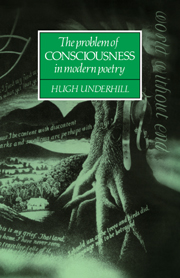Book contents
- Frontmatter
- Contents
- Preface
- Introduction: the inward revolution
- 1 From Georgian origins to ‘Romantic primitivism’: D. H. Lawrence and Robert Graves
- 2 Strangers to nature: modern nature poetry and the rural myth
- 3 The ‘poetical character’ of Edward Thomas
- 4 ‘Myself must I remake’: W. B. Yeats
- 5 ‘Here and now cease to matter’: T. S. Eliot
- 6 The work of Man: Louis MacNeice and W. H. Auden
- 7 ‘Nothing of our light’: Ted Hughes
- Conclusion
- Notes
- Select bibliography
- Index
Introduction: the inward revolution
Published online by Cambridge University Press: 18 December 2009
- Frontmatter
- Contents
- Preface
- Introduction: the inward revolution
- 1 From Georgian origins to ‘Romantic primitivism’: D. H. Lawrence and Robert Graves
- 2 Strangers to nature: modern nature poetry and the rural myth
- 3 The ‘poetical character’ of Edward Thomas
- 4 ‘Myself must I remake’: W. B. Yeats
- 5 ‘Here and now cease to matter’: T. S. Eliot
- 6 The work of Man: Louis MacNeice and W. H. Auden
- 7 ‘Nothing of our light’: Ted Hughes
- Conclusion
- Notes
- Select bibliography
- Index
Summary
‘Consciousness is an end in itself’, wrote D. H. Lawrence in his provocative late work Apocalypse. At least, so it was, he imagines, for the earliest civilizations, before man's arrogant ‘mental consciousness’ got the upper hand and set in motion the long process of misdirection which has culminated in the disaster of modern life. Now, ‘[w]e torture ourselves getting somewhere, and when we get there it is nowhere, for there is nowhere to get to’.
‘The old pagan process of rotary image-thought’ (p. 46) inhered in a way of being which fulfilled the individual, which allowed him to exist at one with his fellows and his surroundings. There was a perfect unity of the outer and the inner life, an absence (I quote now from Cleanth Brooks) of that ‘split between the subjective and the objective’ which plagues modern mankind, none of that ‘chasm between the life of the emotions and attitudes within the poet and the universe outside him … that so much troubled the Romantic poets’. That objections arise to any such notion of an original ‘wholeness’ of consciousness is a point I shall come to. But the terms in which Lawrence talks of this supposed original consciousness of civilized man are remarkably like those often seen as endeavouring to address a modern crisis of consciousness.
- Type
- Chapter
- Information
- The Problem of Consciousness in Modern Poetry , pp. 1 - 20Publisher: Cambridge University PressPrint publication year: 1992



